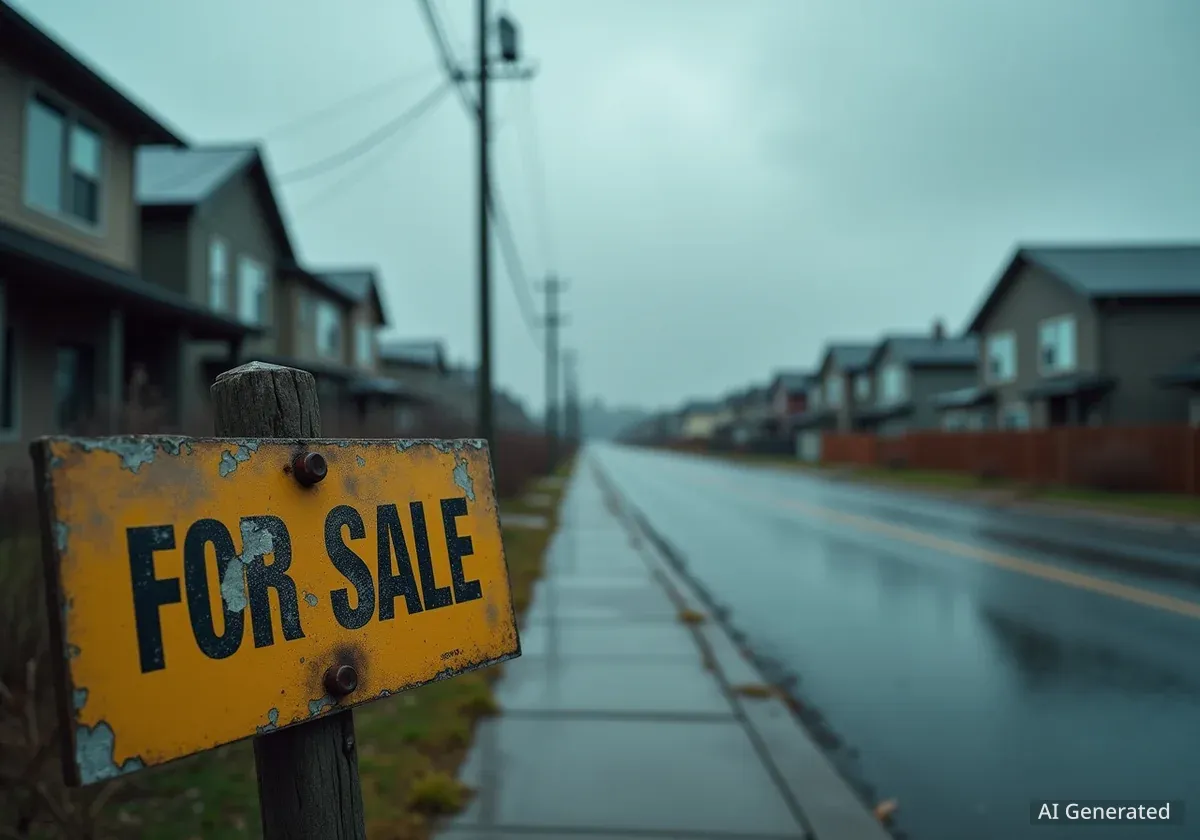Hawaii is facing a severe housing and insurance crisis driven by climate change. Rising sea levels, wildfires, and extreme weather are making insurance unaffordable and difficult to obtain, causing property values in high-risk areas to fall. This situation in the island state provides critical lessons for other vulnerable regions, particularly California, which is experiencing similar challenges.
The combination of natural hazards is pushing Hawaii's real estate and insurance sectors to a breaking point. Homeowners are seeing premiums skyrocket, while some are losing coverage entirely. This has created a complex economic problem that policymakers are now trying to solve with new regulations and state-level support systems.
Key Takeaways
- Climate change is causing a dual crisis in Hawaii's housing and insurance markets, marked by soaring premiums and declining property values in at-risk zones.
- Major threats include wildfires, which have increased in area by 400% since the 1960s, and sea-level rise, projected to increase by one foot by 2050.
- The insurance market is retreating, with premium hikes for single-family homes ranging from 30% to over 100%, and some condominium buildings facing increases as high as 1,000%.
- Hawaii's policy responses, such as mandatory climate risk disclosures and a state-run insurer of last resort, offer a potential roadmap for other states like California.
A State Under Multiple Environmental Threats
Hawaii's unique geography makes it exceptionally vulnerable to a range of climate-related disasters. These environmental pressures are placing an immense strain on the state's already limited and expensive housing supply.
Wildfire and Drought Conditions
Over the last two decades, Hawaii has experienced consistently below-average rainfall, leading to severe drought. According to climate data, the period between 2010 and 2019 was the driest 10-year span in the state's recorded history. These dry conditions, combined with the spread of invasive, fire-prone grasses, have dramatically increased wildfire risk.
The annual area burned by wildfires has grown by 400 percent since the 1960s. The devastating consequences of this trend were made clear by the 2023 Maui fires in Lahaina, which resulted in over 100 fatalities and caused more than $5 billion in property damage.
Extreme Rainfall and Flooding
While drought is a widespread issue, some areas of Hawaii experience intense periods of rainfall. The state's mountainous terrain makes it susceptible to flash floods and landslides during these events. In April 2018, a storm on the island of Kauai dropped nearly 50 inches of rain in just 24 hours. The downpour flooded more than 500 homes and led to an estimated $180 million in damages.
Hurricanes and Sea-Level Rise
Warmer ocean temperatures are increasing the potential intensity and frequency of hurricanes near Hawaii. While direct landfalls are historically uncommon, the threat is growing. Hurricane Iniki, which struck Kauai in 1992, caused damages equivalent to over $5 billion in today's currency, demonstrating the destructive potential of a single storm.
Rising Tides
The National Oceanic and Atmospheric Administration (NOAA) projects that Hawaii will see an additional one foot of sea-level rise by 2050 and nearly four feet by 2100. This will worsen coastal erosion and amplify the impact of storm surges.
Rising sea levels pose a persistent threat to coastal communities. Since 1960, the sea level along Hawaii's coasts has risen between two and eight inches. This gradual increase makes low-lying properties more vulnerable to chronic flooding and erosion, making them difficult and expensive to insure.
Volcanic and Seismic Activity
Beyond climate-related hazards, Hawaii also contends with volcanic eruptions and earthquakes, particularly on the Big Island. Standard homeowners insurance policies do not cover damage from lava flows or earthquakes, forcing residents in high-risk zones to purchase separate, often costly, specialty coverage.
The 2018 Kīlauea eruption serves as a stark reminder of this risk. The event destroyed nearly 2,000 structures, including 700 homes, and highlighted the financial vulnerability of property owners in geologically active areas.
The Insurance Market in Retreat
As climate-related risks intensify, insurers in Hawaii are taking defensive measures. They are dramatically increasing premiums, raising deductibles, and in some cases, refusing to renew policies in the most vulnerable locations. This has created a crisis of affordability and availability for homeowners across the state.
Soaring Premiums and Lost Coverage
Homeowners with single-family properties are reporting premium increases ranging from 30 percent to over 100 percent. For a median-priced home, this can mean an additional cost of up to $6,000 per year. In areas with high exposure to wildfires or coastal flooding, many private insurers are pulling out of the market altogether.
This leaves property owners with few options. Many are forced to turn to the Hawaii Property Insurance Association (HPIA), the state's insurer of last resort. While the HPIA provides a safety net, its premiums are intentionally set high to encourage homeowners to seek private coverage first, making it an expensive alternative for those who need it most.
The Condominium Crisis
The insurance crisis is especially severe for Hawaii's condominium market. According to 2024 legislative testimony, between 375 and 390 condominium buildings were underinsured for hurricane risk. Some condo associations have seen their master insurance policy premiums increase by as much as 1,000%.
These massive cost increases are passed on to residents through higher association fees, threatening housing affordability. The situation is further complicated by secondary mortgage market rules. Major lenders like Fannie Mae and Freddie Mac will not purchase mortgages for units in buildings that are not insured to their full replacement value, effectively freezing sales and refinancing for thousands of condo owners.
Economic Impacts on Hawaii's Housing Market
The instability in the insurance market is having a direct impact on property values. A clear divide is emerging, with homes in high-risk areas losing value while those in safer locations become more expensive.
The 'Climate Penalty' for At-Risk Homes
Research has identified a significant "climate penalty" on homes exposed to chronic flooding and erosion. A recent study found that residential properties in these high-risk zones are valued 9 to 14 percent lower than comparable properties in safer locations. Another report from the University of Hawaii Economic Research Organization (UHERO) noted that homes vulnerable to sea-level rise are already appreciating in value more slowly than inland properties.
These findings suggest that homebuyers and investors are actively pricing long-term climate risks into their decisions. This trend is expected to accelerate following the 2023 Maui fires and the implementation of new laws that mandate climate risk disclosures during real estate transactions.
'Climate Gentrification' and Safe Havens
While risky properties are being devalued, safer ones are becoming more desirable. The UHERO study also found that homes located near the coast but at a higher, safer elevation appreciated in value by about 1 percent more per year than similar homes at lower elevations.
This trend highlights the risk of "climate gentrification." As wealthier buyers seek out properties in less disaster-prone areas, they can drive up prices and displace long-term residents. This creates a new layer of inequality, where the ability to live in a safe location becomes a luxury.
Hawaii's Policy Responses and Lessons for California
Hawaii has implemented several policies to address its interconnected housing and insurance challenges. These strategies offer valuable insights for California, which faces a similar set of problems related to wildfires, floods, and a retreating insurance market.
Hawaii's approach has focused on three main areas:
- Increasing Transparency: The state passed laws requiring mandatory disclosure of climate-related hazards in real estate sales. This ensures that buyers are fully aware of the risks associated with a property before making a purchase.
- Providing a State Backstop: The state reactivated the Hawaii Hurricane Relief Fund to provide a layer of financial support for the insurance market. It also operates the HPIA to ensure that coverage remains available, even if expensive.
- Mandating Data-Driven Planning: Hawaii created a statewide sea-level rise vulnerability report and required counties to incorporate this data into their long-term planning. This has created a standardized, government-validated source of information on climate risk.
"Hawaii reveals a clear 'resilience premium' for safe properties and a 'climate penalty' for vulnerable homes. While Hawaii’s policies have rightfully focused on assessing and understanding risk, these dynamics create a new pressure on the existing housing affordability crisis."
For California, Hawaii's experience underscores the need for proactive measures. California could benefit from mandating more detailed, property-level climate risk disclosures to inform both consumers and insurers. Additionally, Hawaii’s condominium crisis serves as a cautionary tale, suggesting that California should explore alternative insurance models for multi-family dwellings, such as state-backed reinsurance programs or captive insurers for homeowners associations.
By studying Hawaii's challenges and responses, other states can develop strategies to protect their housing markets and residents from the escalating financial risks of climate change.





